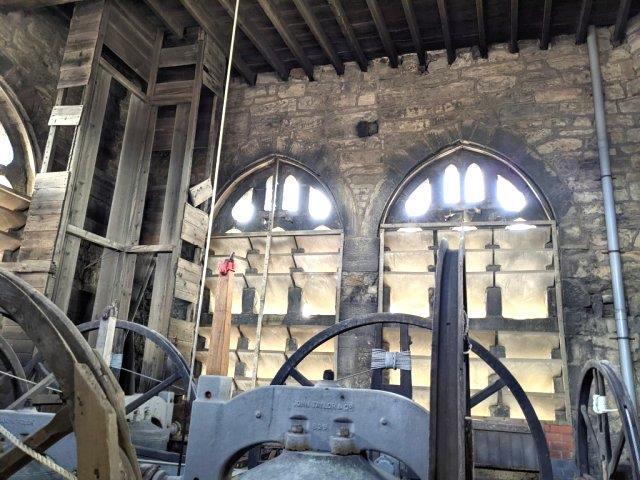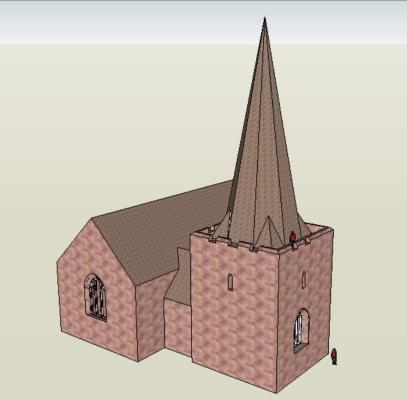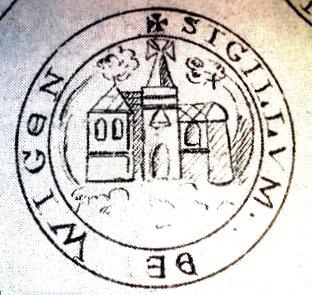
We have now finished our survey at the Parish Church, but the hard work begins trying to establish the different periods of construction. A church in some form would have existed in Wigan since pre-conquest times but, as mentioned in our previous Newsletter 257, the tower itself seems to have started life in the 13th century. This is based on the early Gothic style of both the lancet window in the west wall and the huge arch leading into the church itself. This lower section of the tower is constructed of huge red (Triassic) sandstone blocks which only reach to a height of 12m. At this point the stonework changes to a light grey sandstone. The Y shaped Gothic windows here suggest the tower was extended in the 14th century.  In the Belfry, the style of the huge window openings suggests an early 16th century addition. In the 13th century, building a tower of such a size with its 2m thick walls, would have been a huge undertaking. This was a time however when Wigan had a large Medieval presence, receiving its first Royal Charter in 1246 (one of only four in the whole of Lancashire). At the time it was under the rectorship of John Maunsell, a nationally important and influential chaplain who became Chancellor to King Henry III. He was also a very wealthy man, somebody who could well afford such a construction. In the Belfry, the style of the huge window openings suggests an early 16th century addition. In the 13th century, building a tower of such a size with its 2m thick walls, would have been a huge undertaking. This was a time however when Wigan had a large Medieval presence, receiving its first Royal Charter in 1246 (one of only four in the whole of Lancashire). At the time it was under the rectorship of John Maunsell, a nationally important and influential chaplain who became Chancellor to King Henry III. He was also a very wealthy man, somebody who could well afford such a construction.
This model of the Church and Tower is one of the options we're looking at representing its earliest phase. It is based on other examples such as the Westbury-on-Seven bell tower which is contemporary and has similar proportions. It was originally built as a refuge against Welsh raiding parties, but in Wigan it would have been from baronial unrest which was prevalent at the time.  At Westbury, the bells are located at the base of the spire but in Wigan we think they were located further down as we can find no evidence of openings in the upper part of the tower. We suspect there were openings further down which have subsequently been blocked up. This arrangement also seems to conform to the early Wigan seal which Peter Layland presented to us at last month's meeting. It shows a spire and an opening in the tower (or possibly the bell itself). Peter and I will continue with our research and development of models demonstrating the likely tower construction phases. This will culminate in a report which Peter hopes to publish later in the year (as usual more details on our blog). At Westbury, the bells are located at the base of the spire but in Wigan we think they were located further down as we can find no evidence of openings in the upper part of the tower. We suspect there were openings further down which have subsequently been blocked up. This arrangement also seems to conform to the early Wigan seal which Peter Layland presented to us at last month's meeting. It shows a spire and an opening in the tower (or possibly the bell itself). Peter and I will continue with our research and development of models demonstrating the likely tower construction phases. This will culminate in a report which Peter hopes to publish later in the year (as usual more details on our blog).
Aspull Ring Ditch Project
We have completed another coring survey on the site, this time between Trench 3 and the refilled Trench 4. In this area the bedrock is quite close to the surface (particularly on the outside of the ditch) so it was quite straight forward in detecting where the ditch was. However, there were areas that weren't as clear which present us with sections needing further investigation.
Burscough Roman Fort
Steve Baldwin is looking to continue his investigation here this summer with a series of excavations in the field to the west of the fort. Targets revealed from previous resistivity and radar surveys are potential Roman or early-post Roman archaeological features. These include the road projecting west from the fort and structures which possibly relate to the vicus (i.e. external civilian settlement). The farmer has an early rapeseed crop in the field which is also showing features (beside the usual 19th century drainage system). As before Steve is running the project as a crowd-funded field school (i.e. training dig) with free places for members of the local community. If you want to get involved there is more information on Facebook here.
Next Meeting
Wednesday 3rd May - at the Real Crafty on Upper Dicconson Street starting at 7.30pm as usual. In the winter of 2020 (middle of the Corvid epidemic), Oxford Archaeology North were invited to carrying out a large scale excavations on the Fylde just south of the River Wyre. The project was instigated by Highways England, in advance of the proposed A585 bypass, running from the Windy Harbour junction to Skippool (which is near Poulton-le-Fylde, on the northeast side of Blackpool). Despite having to cope with social distancing and atrocious weather conditions, the team were able to reveal much evidence of prehistoric activity - a fantastic array of artefacts for the Mesolithic, Neolithic and Bronze Age periods, including flint tools, rare pottery sherds and human activity from 6000 year ago. On Wednesday we are privileged to have director of excavations, Fraser Brown to come and give us talk on this very fascinating project. Hope to see you there - BA.
|



